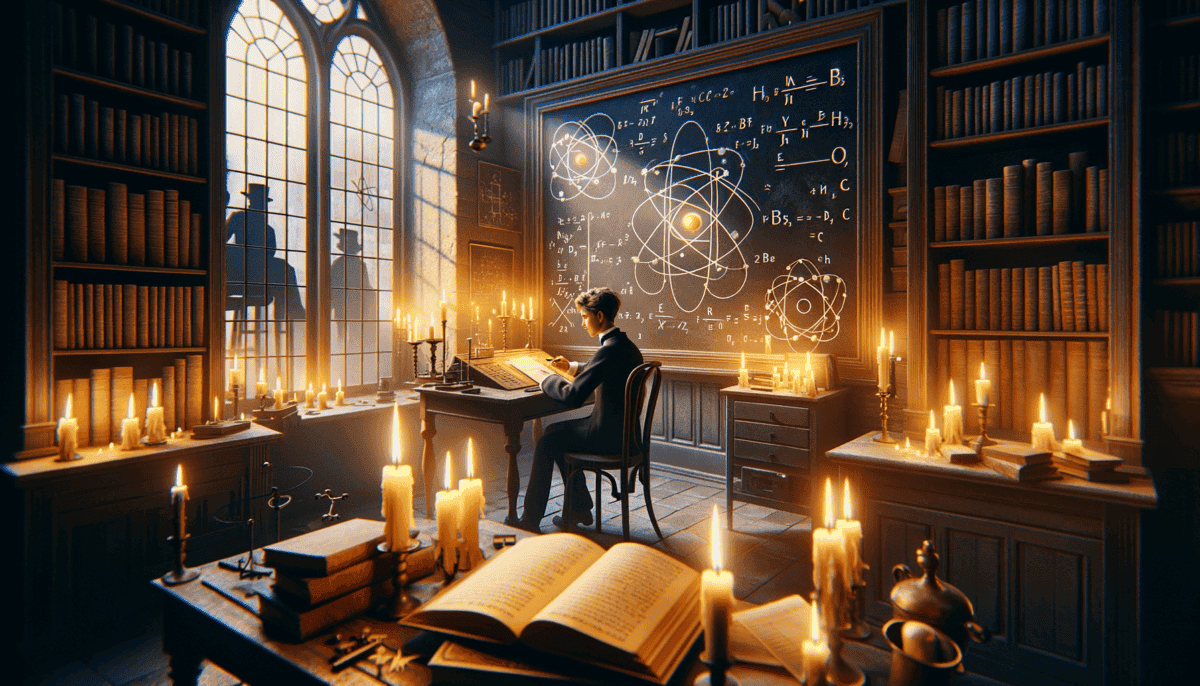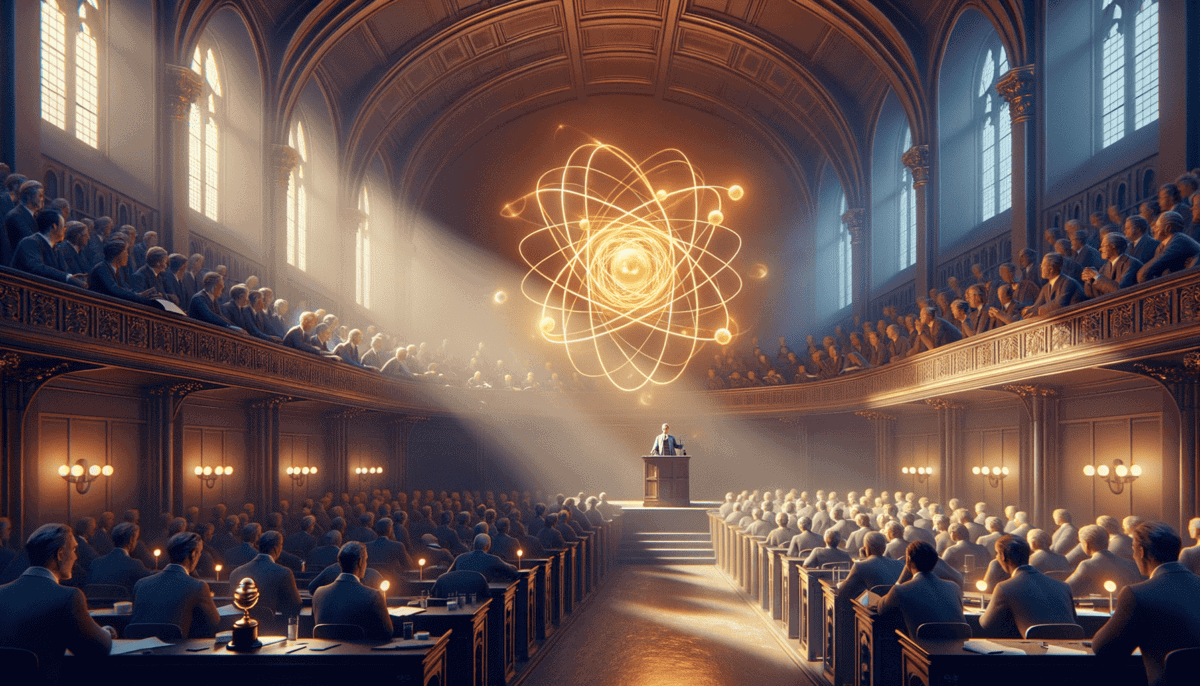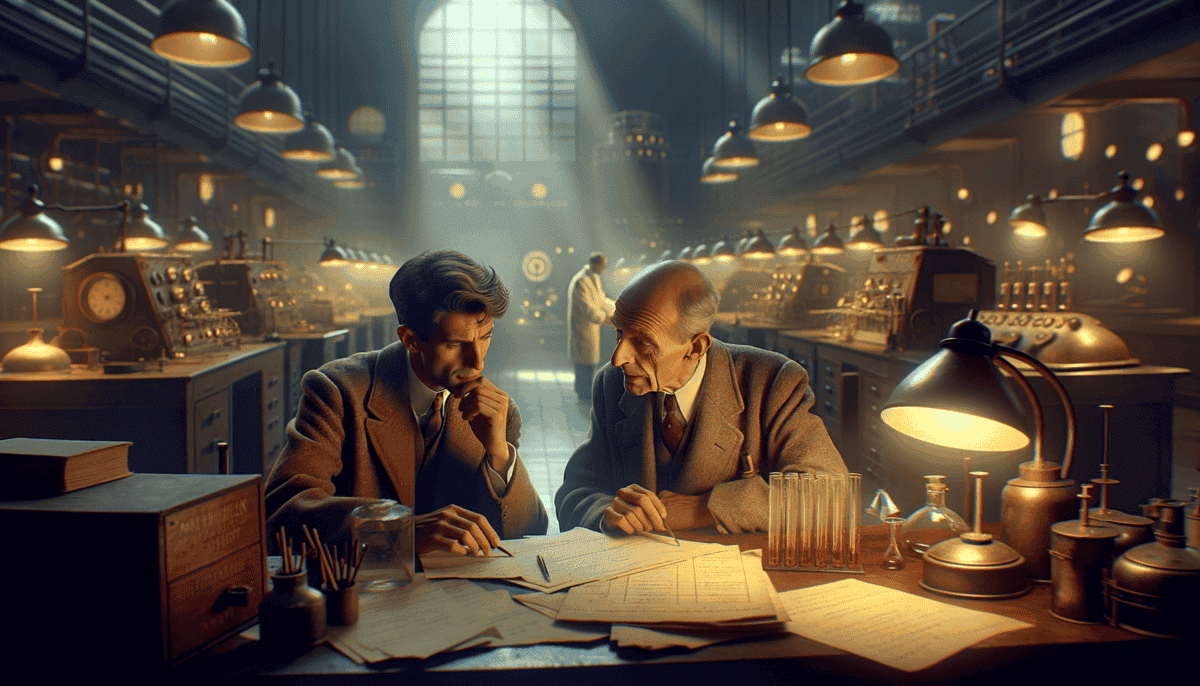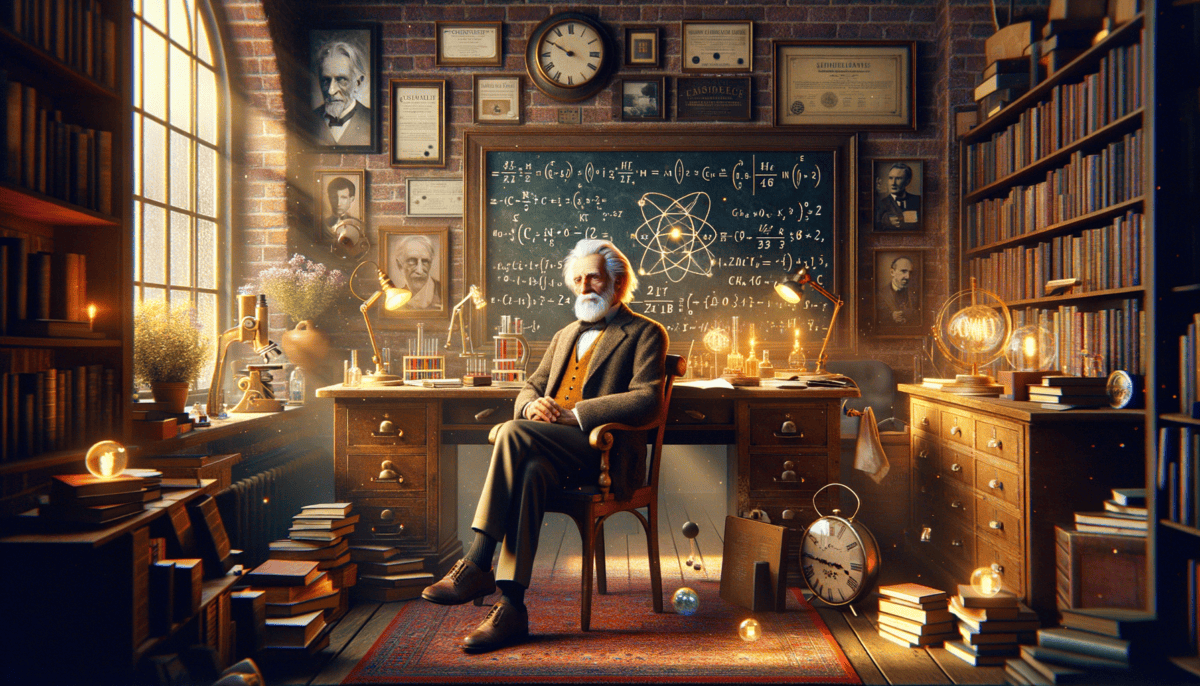Soccer Dreams and Scientific Sparks
The soccer ball soared through the crisp Copenhagen air as young Niels Bohr chased after it. His blonde hair bounced with each step on the grassy field. It was 1895, and ten-year-old Niels loved nothing more than playing soccer with his friends after school.
"Pass it here!" shouted his younger brother Harald, waving his arms excitedly.
Niels kicked the ball perfectly to his brother. Even at soccer practice, his mind worked like a scientist – calculating angles and force just right.
At home, Niels and Harald sat at the kitchen table, surrounded by books. Their father Christian was a professor who loved teaching his sons about science. Their mother Ellen encouraged their curiosity too.
"Why is the sky blue, father?" Niels asked one evening.
Christian smiled. "That's a wonderful question! Let's explore it together."
A Curious Mind Grows
Every day after soccer practice, Niels would rush home to his father's study. The room was filled with interesting things:
• Glass tubes that sparked with electricity
• Colorful rocks and crystals
• Maps of the stars
• Bottles filled with bubbling liquids
"Look at this, Niels," his father said one day, holding up a magnifying glass. "Everything around us is made of tiny particles called atoms. They're so small we can't see them, even with this glass."
Niels's eyes grew wide. "Even me? Even this table?"
"Yes, everything!" Christian laughed. "Scientists are still trying to understand exactly how atoms work."
That was the moment young Niels knew what he wanted to do with his life. He would solve the mystery of atoms!
At school, Niels's teachers noticed how special he was. He could solve math problems faster than anyone else. But he never bragged – he always helped other students understand too.
"You have a gift," his math teacher told him. "Keep asking questions. Keep being curious."
Two Passions Unite
On the soccer field, Niels learned about teamwork and practice. These lessons would help him later as a scientist. His coach always said, "Great players see patterns others miss."
One day, while watching the ball spin through the air, Niels wondered if tiny atoms might move in similar ways. His mind was always connecting soccer and science.
"Harald," he said to his brother as they walked home, "I think playing soccer helps me think better about science."
"How?" Harald asked.
"Well, when I kick the ball, I have to think about where it will go. Science is like that too – trying to predict how things will move and change."
“Maybe someday,” Niels said dreamily, “I’ll understand the biggest game of all – how the whole universe works!”
That night, as stars twinkled outside his window, young Niels drew pictures of what he thought atoms might look like. He didn't know it yet, but his childhood dreams would one day change how everyone understood the world.
His mother found the drawings the next morning. She pinned them on the wall and said, "Keep dreaming big, Niels. Your mind is as boundless as the universe itself."
Little did anyone know that this soccer-loving boy would grow up to be one of the world's greatest scientists. His journey was just beginning, and the atomic mysteries he wondered about were waiting to be solved.
The University Years Begin
The halls of Copenhagen University echoed with excited voices as Niels Bohr walked to his first physics class. The year was 1903, and he was finally where he had dreamed of being.
“Look at all these books!” Niels said to his brother Harald, who had also started university. “There’s so much to learn!”
A New Kind of Game
Though Niels still loved soccer, his mind now played a different game – solving puzzles about atoms. His professors were amazed by his questions.
“Mr. Bohr,” said Professor Hansen, “you think differently than other students. That’s very good!”
One day, Niels drew his idea of an atom on the chalkboard. It looked like tiny balls spinning around a center, like planets around the sun.
“The old ideas about atoms aren’t quite right,” Niels told his classmates. “I think they move in special ways we haven’t figured out yet.”
Making New Friends
At university, Niels met other young scientists who loved big questions. They would talk for hours about atoms, energy, and light.
“What if electrons jump between different paths?” Niels wondered one evening. His friends looked surprised.
“That’s crazy!” said one friend.
“Maybe,” Niels smiled, “but the truth about atoms might be crazier than we think!”
The Big Challenge
Professor Thomson, who had discovered electrons, came to visit from England. He saw Niels’s work and was impressed.
“Young man,” he said, “would you like to come work with me in England?”
Niels’s heart jumped with joy. This was his chance to learn from the best! But first, he had to finish something important.
A Brother’s Support
Late one night, Harald found Niels still working in the library.
“You should rest,” Harald said.
“I can’t,” Niels replied. “I’m so close to understanding something big about atoms.”
“Remember what Dad always says – the best ideas come to a fresh mind.”
Niels smiled. His brother was right. Just like in soccer, you needed rest to play your best game.
Ready for More
As his university years came to an end, Niels knew this was just the beginning. His notebooks were full of new ideas about atoms. His mind was ready for bigger challenges.
“Are you scared about going to England?” Harald asked.
“No,” Niels said, looking at the stars through the library window. “I’m excited. There’s so much more to learn about our amazing universe!”
His professors had taught him well, but Niels knew the biggest discoveries were still ahead. The mystery of atoms was calling, and he was ready to answer.
Journey to the Heart of Atoms
The fog rolled across Cambridge as Niels Bohr stepped off the train. England looked different from Denmark, but his excitement made everything shine. ✨
A New Laboratory
“Welcome to Cambridge, Mr. Bohr,” Thomson said, showing him around. The lab had strange machines Niels had never seen before.
“What does this do?” Niels asked, pointing at a glass tube with wires.
“That helps us see electrons,” Thomson smiled. “But there’s still so much we don’t know.”
Breaking Old Ideas
Niels spent days watching how atoms behaved. The old ideas about atoms didn’t match what he saw.
“Professor Thomson,” Niels said one day, “I think electrons don’t just spin around atoms. They jump between special paths, like players moving on a soccer field!”
Some scientists laughed at Niels’s new ideas. But he knew he was onto something big.
The Big Discovery
One cold morning, Niels drew his new atom model. It showed electrons jumping between different energy levels, like steps on a ladder.
“This changes everything!” said Ernest Rutherford, another famous scientist. “Niels, you’ve helped us see atoms in a whole new way.”
Letters from Home
Harald wrote often from Denmark:
“Dear Niels, Are you changing the world yet? Everyone here is talking about your ideas!”
Niels wrote back: “The atoms keep surprising us. Each answer leads to more questions!”
A Special Prize
News spread about Niels’s atom model. Scientists everywhere started using his ideas. Then something amazing happened.
“Dr. Bohr,” read the letter, “you have won the Nobel Prize in Physics!”
“What does this mean?” asked a young student.
“It means,” Niels smiled, “that sometimes the craziest ideas turn out to be right!”
Looking Forward
As more scientists learned about his work, Niels kept thinking bigger. Atoms were just the beginning.
“What will you discover next?” people asked.
“I don’t know,” Niels said. “But I can’t wait to find out!”
The world of atoms had opened up, and Niels Bohr had helped open the door. His soccer days had taught him to never give up, and now that lesson was helping him score goals in science instead of on the field.
Shadows of War
The year was 1943. Dark clouds hung over the scientific world as Niels Bohr sat in his office, reading a letter marked “URGENT.”
A Difficult Choice
“What should I do?” Niels asked his wife Margrethe. “This could help end the war, but it’s also very dangerous.”
Margrethe touched his hand. “You always say science should help people. Maybe you can make sure it’s used wisely.”
Meeting New Friends
In New Mexico, Niels met J. Robert Oppenheimer, the project leader.
“Welcome to Los Alamos, Dr. Bohr,” Oppenheimer said. “We need your wisdom about atoms more than ever.”
The laboratory was huge, hidden in the desert. Scientists from all over the world worked there.
Hard Questions
Every day, Niels helped solve problems about atoms. But at night, he worried.
“Are we doing the right thing?” he asked Oppenheimer.
“I ask myself that too,” Oppenheimer replied. “We must be very careful with this power.”
A Voice of Peace
Niels wrote letters to important people:
“Dear President Roosevelt,
Atomic power is too big for just one country. We should share what we learn and use it to help everyone.”
Hope for Tomorrow
Some days were hard. Niels missed his family and Denmark. But he kept working, hoping to make a difference.
“What happens after the war?” a young scientist asked.
“Then,” Niels smiled, “we turn this power into something good. We’ll use atoms to make electricity and help sick people get better.”
Sharing Knowledge
Even during the darkest times, Niels taught others about atoms. He believed understanding science could bring people together.
“Remember,” he told his students, “what we learn here isn’t just about bombs. It’s about understanding our world better.”
The desert stars twinkled above Los Alamos. Niels looked up at them, thinking about atoms, peace, and the future. He knew his work here would change the world – he just hoped it would change it for the better.
A Voice for Peace
The year was 1945. The war was over, but Niels Bohr knew his work wasn’t done. He sat in his favorite chair in Copenhagen, thinking about atoms and peace.
Coming Home
“It’s good to be back,” Niels told Margrethe as they walked through their garden. The flowers were blooming again after the long war.
“What will you do now?” she asked.
“I want to build something special – a place where scientists from everywhere can work together.”
The Copenhagen Institute
Niels’s dream came true! He opened a big building called the Copenhagen Institute. Young scientists came from all over to learn about atoms. ✨
“Welcome!” Niels would say. “Here, we study atoms to make the world better, not to make weapons.”
Teaching New Friends
Every day, Niels helped young scientists learn new things. He loved seeing their eyes light up when they understood something new.
“But Dr. Bohr,” one student asked, “how do atoms really work?”
Niels smiled. “Let’s find out together!”
Sharing Ideas
Things Niels wanted to do with atomic science:
• Make electricity for homes
• Help doctors treat sick people
• Learn more about our universe
• Create new materials
A Peaceful World
In his office, Niels kept a special picture – scientists from different countries working together.
“Science brings people together,” he told visitors. “When we share what we know, we can solve big problems.”
Making a Difference
Many people listened to Niels. He helped start special groups where countries could talk about using atomic power safely. ️
“Remember,” he told world leaders, “we share one world. We must work together to make it better.”
Happy Discoveries
The best days were when his students made new discoveries. They would run into his office, excited to share what they found.
“Look, Professor Bohr!” they would say. “We learned something new about atoms!”
Niels looked at the young faces around him, full of hope and curiosity. He knew the future of science was in good hands. The institute buzzed with energy as new ideas bloomed like the flowers in his garden.
A Legacy of Light
The cool autumn breeze swept through Copenhagen in 1962. Niels Bohr sat in his favorite spot at the institute, watching young scientists work. His white hair caught the sunlight as he smiled.
Looking Back
“Tell us about your biggest discovery, Dr. Bohr!” a young student asked during lunch.
Niels’s eyes twinkled. “The most exciting thing wasn’t just finding out how atoms work. It was sharing that knowledge with others like you.”
Special Moments
Margrethe brought out an old photo album. Inside were pictures that told Niels’s story:
• A young boy with a soccer ball
• A student learning about atoms
• Meeting Einstein and other famous scientists
• Working with students at his institute
• Receiving the Nobel Prize
Magic of Science
“Science is like a wonderful story that never ends. Each discovery leads to new questions!” – Niels Bohr
The institute halls echoed with happy voices. Students from all over the world worked together, just as Niels had dreamed.
Helping the World
His work made it possible for doctors to help sick people. Scientists used his ideas to make better computers. Even the TV in your house works because of what Niels taught us! ✨
Special Gift
“What makes you happiest, Grandfather?” his grandson asked one day.
Niels looked at the busy institute around him. “Seeing young people excited about science. They will make tomorrow better than today.”
Forever Shining
Today, Niels Bohr’s ideas still light up our world. His institute continues to welcome curious minds. Scientists still use his atomic model to understand our universe.
Every time someone looks through a microscope or wonders about atoms, they follow the path that Niels Bohr helped create. His story shows us that with curiosity, kindness, and hard work, one person can help make the world brighter for everyone.
Somewhere, maybe a young child is looking up at the stars or playing with a science kit. They might be the next Niels Bohr, ready to unlock new mysteries and share them with the world. The adventure of discovery continues, just as Niels would have wanted.






